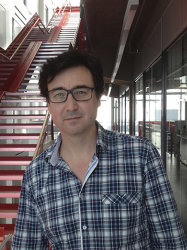Summary
Tristan Rodríguez joined the National Heart and Lung Institute (NHLI) in 2011.
Tristan Rodríguez trained as an embryologist in the laboratory of the late Dr. Rosa Beddington (National Institute for Medical Research, London, Mill Hill), who was a key figure in establishing the early mouse embryo as a model system to understand cell fate. In 2002 he was awarded a Lister Institute of Medicine non-clinical fellowship to work on axis specification in the mouse embryo and moved to the MRC Clinical Sciences Centre to initiate this work. At the end of 2011 the Rodriguez laboratory moved to NHLI as part of a new cardiovascular initiative. Here, the research group is focussed on studying the regulation of cell fitness during development and understanding the selective pressures that act to remove suboptimal cells from the embryo. For this the Rodríguez group takes three approaches that combine the fields of embryology, cell metabolism and cell signalling.
The first approach is to analyse the cell intrinsic determinants of cell fitness with a specific focus on the mitochondria. For example the group studies how changes in the balance of mitochondrial fusion and fission allows the embryo to adapt its apoptotic threshold to the changing metabolic requirements that take place during embryonic development. The group also studies the importance that mitochondrial DNA copy number and sequence has on mitochondrial performance during differentiation.
The second approach that the group takes is to study the cell non-autonomous mechanisms that regulate cell fitness. For this the focus is on cell competition, a quality control mechanism that allows the comparison of fitness levels between cells and results in the elimination of those cells that are less fit than their neighbours, even though they may be viable in a different context. An important implication of our work is that cellular fitness is not only a cell-intrinsic property, but is also determined relative to the fitness of neighbouring cells– a cell that is of sub-optimal fitness in one context may be ‘super- fit’ in the context of a different cell population. The group analysis the mechanisms by which cell fitness is measured between cells and the pathways that respond to this fitness sensing by promoting apoptosis in the less-fit cell type or proliferation in the fitter cell.
Finally, the group also studies the importance of cell competition in disease. For example the importance that cell competition has in the expansion of cancer cells. For this they study how transformed cells such as glioblastoma stem cells use cell competition to eliminate their un-transformed neighbours as a mechanism to expand within the neural stem cell niche.
Selected Publications
Journal Articles
Nichols J, Lima A, Rodriguez T, 2022, Cell competition and the regulative nature of early mammalian development, Cell Stem Cell, Vol:29, ISSN:1934-5909, Pages:1018-1030
Pernaute B, Pérez-Montero S, Sánchez Nieto JM, et al., 2022, DRP1 levels determine the apoptotic threshold during embryonic differentiation through a mitophagy-dependent mechanism., Dev Cell, Vol:57, Pages:1316-1330.e7
Montero SP, Bowling S, Pérez-Carrasco R, et al., 2022, Levels of p53 expression determine the competitive ability of embryonic stem cells during the onset of differentiation
Lima A, Rodriguez TA, 2021, MHC-I presents: tumor surveillance in the epithelia by cell competition, Nature Immunology, Vol:22, ISSN:1529-2908, Pages:1358-1360
Price CJ, Stavish D, Gokhale PJ, et al., 2021, Genetically variant human pluripotent stem cells selectively eliminate wild-type counterparts through YAP-mediated cell competition, Developmental Cell, Vol:56, ISSN:1534-5807, Pages:2455-2470.e10
Lima A, Lubatti G, Burgstaller J, et al., 2021, Cell competition acts as a purifying selection to eliminate cells with mitochondrial defects during early mouse development, Nature Metabolism, Vol:3, ISSN:2522-5812, Pages:1091-1108
Lawlor K, Marques-Torrejon MA, Dharmalingham G, et al., 2020, Glioblastoma stem cells induce quiescence in surrounding neural stem cells via Notch signalling, Genes & Development, Vol:34, ISSN:0890-9369, Pages:1599-1604
Roman-Trufero M, Ito CM, Pedebos C, et al., 2020, Evolution of an amniote-specific mechanism for modulating ubiquitin signalling via phosphoregulation of the E2 enzyme UBE2D3, Molecular Biology and Evolution, Vol:37, ISSN:0737-4038, Pages:1986-2001
Bowling S, Lawlor K, Rodriguez T, 2019, Cell competition: The winners and losers of fitness selection, Development, Vol:146, ISSN:0950-1991, Pages:1-12
Bowling S, Di Gregorio A, Sancho M, et al., 2018, P53 and mTOR signalling determine fitness selection through cell competition during early mouse embryonic development, Nature Communications, Vol:9, ISSN:2041-1723
Lima A, Burgstaller J, Sanchez Nieto JM, et al., 2017, The mitochondria and the regulation of cell fitness during earlymammalian development, Current Topics in Developmental Biology, Vol:128, ISSN:0070-2153, Pages:339-363
Pernaute B, Spruce T, Smith KM, et al., 2014, MicroRNAs control the apoptotic threshold in primed Pluripotent stem cells through regulation of BIM, Genes & Development, Vol:28, ISSN:0890-9369, Pages:1873-1878
Sancho M, Di-Gregorio A, George N, et al., 2013, Competitive Interactions Eliminate Unfit Embryonic Stem Cells at the Onset of Differentiation, Developmental Cell, Vol:26, ISSN:1534-5807, Pages:19-30
Cambray S, Arber C, Little G, et al., 2012, Activin induces cortical interneuron identity and differentiation in embryonic stem cell-derived telencephalic neural precursors, Nature Communications, Vol:3, ISSN:2041-1723
Clements M, Pernaute B, Vella F, et al., 2011, Crosstalk between Nodal/Activin and MAPK p38 Signaling Is Essential for Anterior-Posterior Axis Specification, Current Biology, Vol:21, ISSN:0960-9822, Pages:1289-1295
Stuckey DW, Clements M, Di-Gregorio A, et al., 2011, Coordination of cell proliferation and anterior-posterior axis establishment in the mouse embryo, Development, Vol:138, Pages:1521-1530
Spruce T, Pernaute B, Di-Gregorio A, et al., 2010, An Early Developmental Role for miRNAs in the Maintenance of Extraembryonic Stem Cells in the Mouse Embryo, Developmental Cell, Vol:19, ISSN:1534-5807, Pages:207-219

